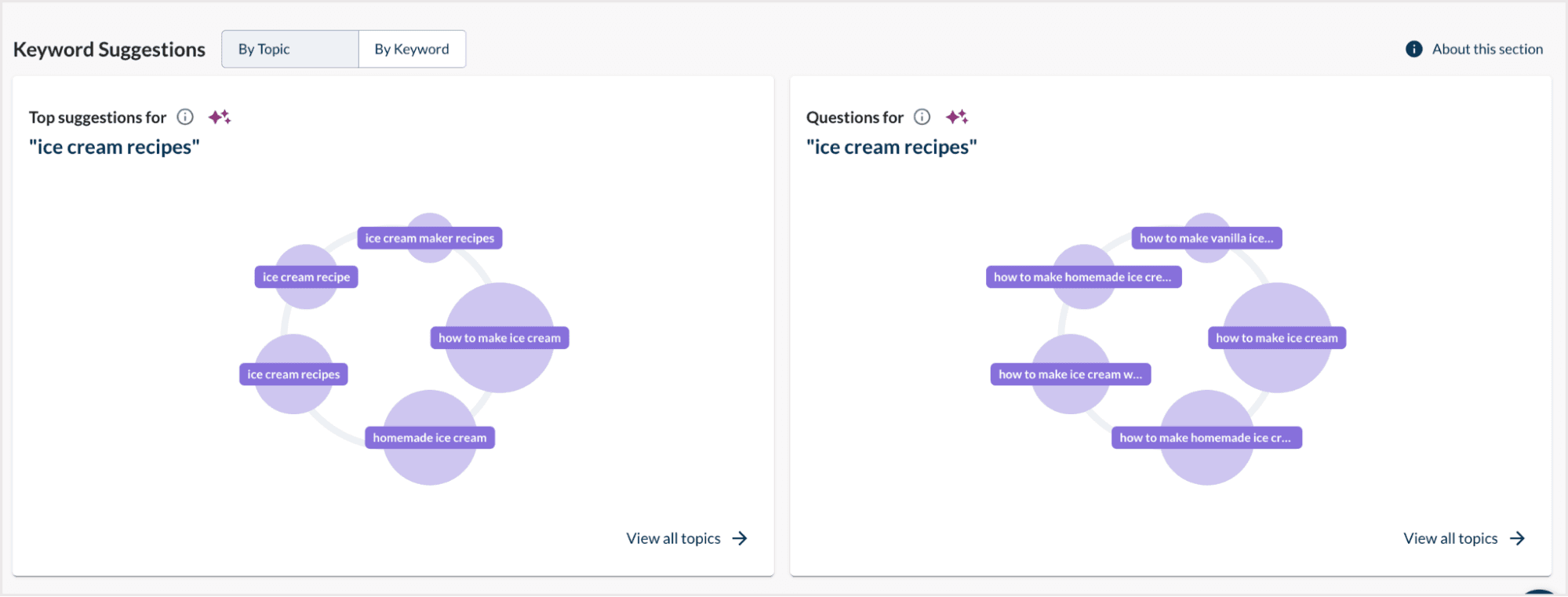Explore By Keyword
Frequently Asked Questions
What’s Covered?
In this guide, you’ll learn more about Keyword Overview in the Explore by Keyword section of the Keyword Explorer tool.
Quick Links
Getting Started with Explore by Keyword
Explore by Keyword is your one-stop shop for researching specific keywords and analyzing SERP data.
To get started, follow the steps below:
- Head to the Explore by Keyword section of Keyword Explorer
- Enter the keyword that you’d like to research
- Use the drop-down to select the locale & language you’d like to see data for
- Click Analyze

Overview
After entering your keyword and clicking Analyze, you’ll see the following information:
A. Monthly Volume — The number of searches for that keyword for any given month — this is an indication of demand for that keyword.
B. Organic CTR — This metric estimates the percentage of clicks that are available to traditional, organic links in the SERP. A lower percentage indicates more SERP features are present in the SERP.
C. Difficulty — This metric estimates how hard it would be to rank in the top 10 positions in the SERP for this keyword. A higher score indicates it is more difficult to rank for this keyword.
D. Minimum Domain Authority — The lowest Domain Authority of the pages currently ranking in the SERP for this keyword.
E. Primary Search Intent — The primary search intent associated with this keyword. Use this to better understand where in the customer journey people are when they are searching for this keyword and what kind of content will best serve their needs.
F. SERP Features — An overview of the SERP features found in the SERP for this keyword.

Keyword Suggestions Preview
Below the metrics overview are two Keyword Suggestion previews. By default, you will be shown suggestions by topic, but you can also see them by keyword.
- Top Suggestions — This module shows you a preview of the top keyword topics associated with this keyword.
- Questions — This module shows you a preview of topics that contain your keyword query and are in the form of a question.

Click on any topic bubble to see more information about the keywords included in the group. To see more suggestions of each type and additional keyword suggestions, click View all at the bottom of the module. This will take you to the Keyword Suggestions section of the tool.

SERP Analysis
SERP Analysis offers a snapshot of the SERP for the keyword entered, alongside link and authority metrics. Within the SERP Analysis module, you will find the following information.
A. Rank — The position in the SERP.
B. Title — The title tag for the rankings page.
C. URL – The URL for the ranking page.
D. SERP features — This column will note if the result is a SERP feature or includes a SERP feature (like reviews, images, etc.).
E. PA – The Page Authority for the ranking page. Page Authority is a Moz proprietary metric from 1 to 100 that predicts how well a page will rank in Google based on a machine learning algorithm for link metrics.
F. DA – The Domain Authority for the ranking domain. Domain Authority is a Moz proprietary metric from 1 to 100 that predicts how well a domain will rank in Google based on a machine learning algorithm of link metrics.
G. BA – The Brand Authority for the ranking domain. Brand Authority is a score developed by Moz that measures a domain’s total brand strength as a 1-100 score.
H. LRDs to page – The number of unique root domains linking to the ranking page. Two or more links from the same website will only be counted as one linking root domain.
I. Page Score – A score representing how well-optimized this page is for the given keyword based on our On-Page Grader tool. Click on the score to view the full report.

For some SERP feature results, more information will be available. This will be indicated with an arrow to the right of the SERP Feature callout. Click the arrow to expand the results and see more information about what is included in the given SERP Feature.

Where applicable, the URL of the content featured will be provided. If information about more than one SERP feature is available for a given result, tabs will be used to switch between the different features. Click the tab of the result you want to see information for.

Understanding Keyword Overview Terminology
More information about Keyword Metrics is available in the Keyword Metrics section. More definitions for Moz Pro terminology can be found in our glossary.
Monthly Volume — The number of searches for that keyword for any given month — this is an indication of demand for that keyword.
Difficulty — Shows you how hard it would be to rank in the top 10 positions in the SERP for this keyword.
Organic CTR — An estimated relative click-through rate for organic web results for this keyword.
Priority — Combines all our other metrics to create a single, sortable number you can use to effectively prioritize keywords.
Page Authority — A Moz proprietary metric from 1-100 which predicts how well a page will rank in Google based on a machine learning algorithm of link metrics.
Domain Authority — A Moz proprietary metric from 1-100 which predicts how well a domain will rank in Google based on a machine learning algorithm of link metrics.
Was this article helpful?
![]() Yes! Amazing!
Yes! Amazing!
![]() Yes! It was what I needed.
Yes! It was what I needed.
![]() Meh. It wasn’t really what I was looking for.
Meh. It wasn’t really what I was looking for.
![]() No, it wasn’t helpful at all.
No, it wasn’t helpful at all.
Thanks for the feedback.